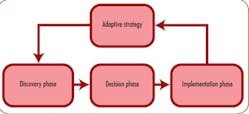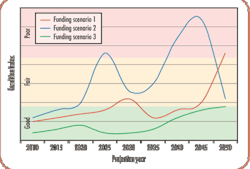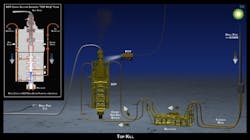By Farhan Shaikh
In today’s age of decreasing budgets, the demand for public funding and the competition among local, state, and federal officials for scarce resources generally results in officials making decisions that provide only for the most immediate needs. Decisions about long-term capital expenditures usually get deferred. Often officials do not have the ability to evaluate the risks associated with their decisions and the consequences of deferring maintenance or capital improvements that extend into the future well beyond their time in office.
Figure 1. A high level summary of the asset management planning process. Image: Critigen.
Technology approaches, which include modeling tools, decision support tools, and rational methodology, can provide decision makers with the ability to prioritize the limited funds available for cost-effective management of their assets. These approaches will provide managers and operations staff with the ability to predict infrastructure rehabilitation/replacement costs well into the future and provide the tools for justifying the funding decisions necessary to meet the desired levels of service. In addition, these approaches guard against rate and tax volatility for utility operations, and reduce more expensive reactive maintenance and equipment downtime.
What Is Asset Management?
For roads, buildings, and water and wastewater systems, asset management is managing infrastructure capital assets to minimize the total ownership and operation costs while delivering customers’ desired service levels at an acceptable risk level. A quality approach to asset management requires a coordinated, comprehensive process. This approach provides the critical documentation to communicate with policy makers and stakeholders about needed investments. It also provides the most cost-effective results because it allows the use of strategic direction and risk determination to set priorities.
Why Consider Asset Management?
Knowing the condition of your assets, and knowing where to prioritize rehabilitation and replacement spending, helps agencies preserve assets, maintain reliable service, and understand long-term financial needs. It also contributes to rational and defensible capital improvement plans that will be supported by the public and elected officials. Asset management is a way to target areas where spending is crucial to manage risks associated with potential asset failures — thereby optimizing spending to keep systems working reliably and customers satisfied.
Asset Management Basics
The initial investment in any capital program — creating the asset in the built environment — is only a small part of its total life-cycle cost. How the asset is managed, operated, and maintained will have a great deal to do with outcomes for the asset. Outcomes can be measured in total life, condition during life, and costs of operating and maintaining the asset (see Fig. 1).
Systems now exist to help the asset manager optimize operation of assets from cradle to grave. These systems focus on asset system knowledge, proactive management, and just-in-time maintenance and capital renewal investment.
Discovery Phase
Performance and Service Levels
Establishing objectives for level of service and performance is a fundamental requirement for the management of any asset. Level of service is a policy issue and is the bar by which both policy bodies and asset managers will be measured. It also establishes the parameters within which the asset is to be managed.
Asset Inventory
An asset inventory may be as simple as an Excel or Access spreadsheet, or it may be a Computerized Maintenance Management System (CMMS) or a Geographic Information System (GIS). As with other elements of an asset management system, it is very important to prioritize inventory levels to be collected and maintained. Collecting and maintaining too much information will result in a system that is too expensive to operate and that often fails because of unnecessary complexity.
Figure 2. Condition index scenario analyses. Image: Critigen.
Condition Assessments
Identifying deficiencies in a system and valuing correction of those deficiencies provides information that is used in several asset management processes. Various tools can be used to anticipate deficiencies in the short term. Maintenance management records can log maintenance action frequencies and maintenance costs. If electronic records are not available, field logs or staff interviews can be used as a starting point.
Information Systems
For any data-intensive exercise the ability to store and retrieve data quickly is of paramount importance. There are dozens of CMMS programs available in the marketplace that are extremely comprehensive. The core of any of these programs is the asset inventory database. From this database an array of tools can be driven, such as recurring maintenance work orders, emergency work orders, maintenance histories, stores inventories, purchase order creation and tracking, work and staff planning, performance reporting, and other modules that support proactive asset management.
Selecting the best program can be a complex undertaking. Because the CMMS can be a key element in an asset management system, selection of a particular program should be made keeping in mind how best the CMMS program supports and integrates into the overall asset management system and other information systems within the enterprise.
Ranking and Prioritization
One way to prioritize facility needs is to track the relative condition or “health” of a facility. A Condition Index is a simple but powerful tracking tool. It is calculated as the cost of facility deficiencies stated as a percentage of current replacement value. This helps set relative funding priorities and measures the duration of deferred deficiency reduction.
Budgets can be projected at various levels, and the condition index can be used to forecast how the condition of the asset, or group of assets, will be affected. If the budgeted investment is the same as the required capital renewal amount, the index will remain the same. If greater or lower investment levels are budgeted, the projected index will show improvement or deterioration, respectively (see Fig. 2).
Decision Phase
Risk Assessment
Risk analysis is another policy issue. What are the risks, how much risk should be taken, and what is the cost of not mitigating the risk? The answers to these questions involve use of structured processes within a workshop environment. This workshop involves all parties: policy body, operations staff, financial officers, risk managers, and so forth, in identifying and mitigating risks. Conducting this exercise will identify risks in advance so that when a failure or disruption occurs, it is managed as opposed to being addressed reactively.
The avoidance of major service disruptions, collateral damage, safety and health threats, large remediation costs, and liability costs is the ultimate objective of risk management. Continued trouble-free operations are another benefit of risk management. Unmitigated risk costs can often far exceed the cost of normal operations and maintenance.
Prioritization of Service Levels
It is important to determine what is really important in most anything we do. Often, determining what is important in asset management is a policy body or senior management decision. Business Process Reengineering (BPR) is a highly focused process to diagram existing processes to determine the priorities that have been assigned, the essential work that is being done, and the expected outcomes. Armed with this information, processes can be redesigned. BPR is usually conducted using workshops involving both policy and operational staff, as appropriate.
In general, the prioritized inventory should be developed to the highest hierarchical level, first with individual elements being shown, next with entire or segmented systems, and finally by grouping similar facilities, components, and systems until an entire inventory can be comprised. Following this process will reveal some noncritical components that should be grouped for accounting but not accountability purposes.
Implementation Phase
Financial and Budgetary Planning
Using the infrastructure asset management programs and tools, the capital renewal element can be calculated with some certainty. Likewise, by capturing more information about maintenance activities, projections of these costs can be made accurately. Having systems that incorporate these processes into a complete planning system for managing an organization’s infrastructure will deliver on the strategic goals. This will increase system reliability and reduce unpredictable legal and system failure costs, as well as the cost of operations, without major institutional or cultural change or large up-front investment.
Financial and rate planning should be an on-going activity. Annual updates to the condition of the system and related capital and operating requirements can be made and used as inputs to the budgeting and rate-setting processes. By developing a multi-year planning horizon that incorporates appropriate renewal and replacement provisions, rate increases, if needed, can typically be planned in an incremental manner rather than requiring sudden individual rate increases to respond to system failure or inefficient replacement (see Fig. 3).
Figure 3. Asset management and financial planning. Image: Critigen.
Adaptive Asset Management Strategy
Monitoring the effectiveness of asset management strategies, and making adjustments as understanding grows, is the essence of an ‘adaptive approach.’ The operational foundation of an adaptive approach is periodic infrastructure assessments, using modeling to predict outcomes, and monitoring to test the predictions. If results do not correlate to predicted outcomes then adapting to the lessons learned will help strengthen the overall plan.
Modernizing Asset Management: Choosing Systems and Integrating Them
Selecting Systems
The complexity and sheer number of mature and emerging technology management options also makes it difficult to discern which combination of options is appropriate for your organization. With a magnitude of factors depending upon the right solution, there is no room for trial and error. Selecting the best program can be a complex undertaking. Because the CMMS can be a key element in an asset management system, selection of a particular program should be made keeping in mind how best the CMMS program supports and integrates into the overall asset management strategy. It is a known fact that the rate of failure in implementing a new IT system is high. Most of this is caused because enough consideration has not been given to how a new system will impact current processes and environments. Doing an assessment up front can help avoid these pitfalls. Figure 4 demonstrates a needs assessment methodology that does exactly that.
Information System Integration
Virtually all of the tools, systems, and programs for infrastructure asset management can now be electronically linked. Before diving into integration, it is helpful to identify which systems or process can be affected. Below is an example of what could come out of such an exercise.
Business Processes Affected
- Service Account Management
- Service Billing
- Payment Processing and Collections
- Maintenance (all)
- Water Resources Management
- Water Production
- Wastewater/Environmental Management
- Engineering
- Inventory and Warehousing Systems Impacted
- Customer Information System
- Billing & Payment Processing
- MMS
- GIS
- Analytical Models
- SCADA Integration with Enterprise Applications (MMS)
- ERP Integration (Interface with Finance, HR, Purchasing)
- Security (Access Control, Camera Surveillance, etc.)
- Intranet/Extranet/Internet Applications
There are obvious advantages when one system can use data from another. Data duplication and the implicit opportunity for error are eliminated. Some of the additional benefits from these technologies include:
- Uses industry standards for communication and protocols
- Allows cross-platform communication
- Allows for future changes in platforms without major reprogramming
- Security programs are already established
- Users can be added at little or no cost
- Most users understand the web browser, thus reducing training costs
- Most data can be stored on a server where it can be maintained in a more secure environment
Summary
Asset management is most effective when it is undertaken in a measured way that avoids unnecessary organizational disruption. Once an agency defines its current position, it can chart a workable course beginning with just one geographic portion of its system, or specific asset categories based on a high-level risk assessment of major infrastructure components. It can facilitate compliance with regulations such as Capacity Management Operations and Maintenance (CMOM) and GASB 34 Regulations. If done in an integrated fashion, it can:
- Make the agency highly competitive
- Reduce total operational cost
- Justify incremental spending to reduce overall costs of service
- Allocate dollars based on priorities
- Build confidence in facility and asset management
About the Author:
Farhan Shaikh specializes in Utility Management Solutions and Water Resources Technology for Critigen (www.critigen.com/lbx). He has worked with cities and counties all over the nation, helping to bridge the gap between information technology and water sector needs, and has designed tools that assist local governments streamline business processes in the areas of Asset Management, Pollutant Trading, Watershed Protection, Water Quality Monitoring, Economic Analyses, and Quality Assurance/Quality Control. He may be reached at: [email protected].







